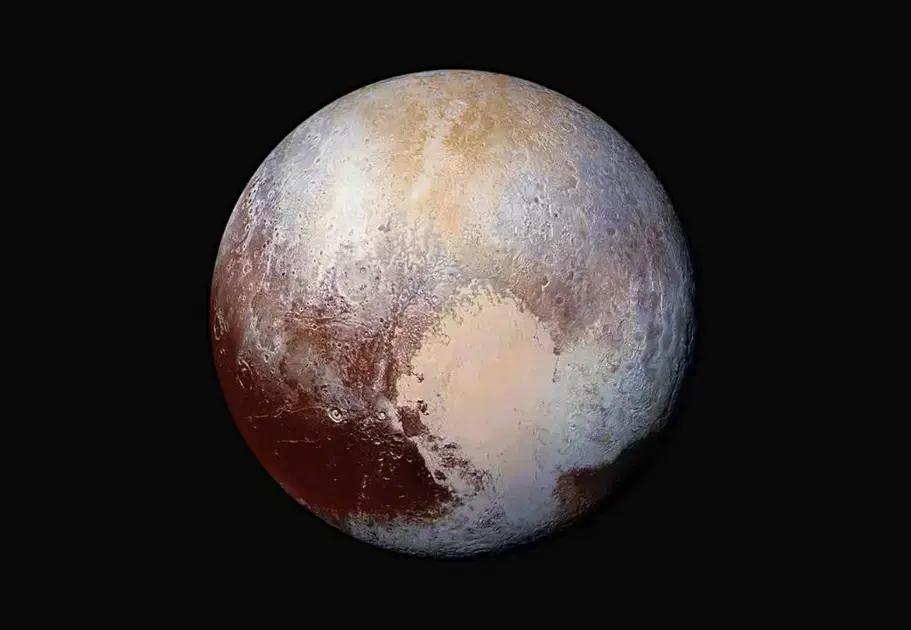“`html
Pluto’s largest moon, Charon, has intrigued scientists for years. New research suggests a fascinating twist in the origin of Pluto’s largest moon. This challenges earlier beliefs about its formation.
Origin of Pluto’s Largest Moon: The “Kiss and Capture”
A recent study proposes a “kiss and capture” scenario for the origin of Pluto’s largest moon. This theory suggests that Pluto and Charon grazed each other billions of years ago. This gentle collision contrasts with the violent impact theory previously accepted.
The older theory posited a massive collision similar to the Earth-Moon formation. Debris from this impact would then coalesce to form Charon. New evidence challenges this narrative.
Instead, the “kiss and capture” suggests the two bodies briefly merged. They formed a temporary contact binary before separating. This separation resulted in the stable, gravitationally bound system we see today.
This gentle interaction helps explain why Charon’s composition differs so much from our own moon. Want to learn more about other moons in our solar system? Check out our article about capturing breathtaking photos of celestial bodies.
Origin of Pluto’s Largest Moon: A Gentle Encounter
This new theory about the origin of Pluto’s largest moon arises from differences between the Pluto-Charon system and the Earth-Moon system. Pluto and Charon are significantly smaller and colder. They are composed of icy material, not molten rock like the early Earth and Moon. These differences played a crucial role in their formation.
Simulations show this icy composition allowed both bodies to survive the collision largely intact. Unlike the Earth-Moon impact, less debris was generated. This allowed Pluto and Charon to retain their original compositions. They then settled into their present orbits. Interested in the latest tech gadgets? See our coverage of innovative new releases at CES 2025.
The near-perfect alignment of Pluto’s orbital axis with Charon’s path is telling. It strongly supports the “kiss and capture” theory for the origin of Pluto’s largest moon. This alignment suggests a shared rotational origin after the collision. Looking for affordable smartwatches? Discover options that won’t break the bank.
Additional simulations reinforce the gentle collision theory. They successfully reproduce the observed orbital characteristics of Pluto and Charon. The “kiss and capture” hypothesis now carries significant weight. Did you know Jeff Bezos’ Blue Origin is also exploring space? Read about his plans to challenge Elon Musk.
Origin of Pluto’s Largest Moon: Implications for Planetary Formation
Unraveling the origin of Pluto’s largest moon doesn’t just illuminate the Pluto-Charon system. It has much broader implications. This discovery highlights the diverse processes at play in planetary formation within our Solar System. The outer, icy regions appear to evolve quite differently from the inner, rocky zones.
This research underscores the importance of ongoing study. The origin of Pluto’s largest moon serves as a great example. It emphasizes how much we still have to learn about planetary evolution. Want to know more about the new study? Dive into the latest research.
This new understanding of the origin of Pluto’s largest moon has changed our perspective on how celestial bodies form and interact. It underscores how much we still have to learn about the universe. With ongoing space missions and improved technologies, we’re always finding new information, like these updates on upcoming gaming consoles.
This knowledge about the origin of Pluto’s largest moon is crucial to understanding the complexities of celestial mechanics. Just like we’re constantly improving our understanding of AI and its performance, as discussed in this article on NVIDIA’s benchmarks.
Further research will continue to refine our model of the origin of Pluto’s largest moon. New discoveries may yet reveal more surprises about this fascinating celestial pair. Are you interested in keeping up with the latest AI advancements? Check out more news about AI and technology.
Via BGR
“`


